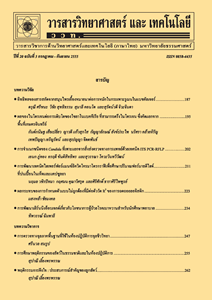การบำบัดน้ำเสียจากกระบวนการผลิตเยื่อกระดาษด้วยปฏิกิริยาโฟโต-เฟนตันและโซโน-เฟนตัน
Main Article Content
Abstract
บทคัดย่อ
กระบวนการโฟโต-เฟนตันและโซโน-เฟนตัน เป็นกระบวนการออกซิเดชันขั้นสูง สามารถย่อยสลายสารอินทรีย์ที่ย่อยสลายยากได้ โฟโต-เฟนตันและโซโน-เฟนตัน จะใช้รังสียูวีและคลื่นอัลตราซาวด์ช่วยเพิ่มประสิทธิภาพการย่อยสลายให้กับกระบวนการเฟนตันโดยทั่วไป น้ำเสียจากกระบวนการผลิตเยื่อกระดาษประกอบด้วยลิกนินและอนุพันธ์ของลิกนิน ซึ่งทำให้น้ำเสียมีค่าซีโอดีและความเข้มสีสูง จุดมุ่งหมายในการศึกษาครั้งนี้เพื่อบำบัดน้ำเสียจากกระบวนการผลิตเยื่อกระดาษ โดยใช้กระบวนการโฟโต-เฟนตันและโซโน-เฟนตัน ค่าซีโอดีและความเข้มสีเริ่มต้นของน้ำเสีย คือ ประมาณ 2,000 มิลลิกรัมต่อลิตร และ 3,000 ADMI ตามลำดับ โดยศึกษาสภาวะที่เหมาะสมในการบำบัดค่าซีโอดีและความเข้มสีด้วยกระบวนการโฟโต-เฟนตันด้วยการแปรผันค่าความเข้มแสงที่ใช้ในการเกิดปฏิกิริยา 0-500 ลักซ์ และระยะเวลาในการฉายแสงอัลตราไวโอเลต 0-40 นาที ส่วนการบำบัดด้วยกระบวนการโซโน-เฟนตันนั้นแปรผันระยะเวลาในการให้คลื่นความถี่เหนือเสียงในการเกิดปฏิกิริยา 0-40 นาที ในการทดลองจะให้ค่าความเข้มข้นเฟอรัสไอออน 0.03 โมล ความเข้มข้นไฮโดรเจนเปอร์ออกไซด์ 0.06 โมล และค่าความเป็นกรดด่าง 3 คงที่ โดยทำกลุ่มควบคุมด้วยการใช้น้ำกลั่น การทดลองมี 3 ซ้ำ ผลการทดลองระบุว่าประสิทธิภาพในการบำบัดซีโอดีและสีสูงที่สุด เมื่อให้ค่าความเข้มแสงที่ใช้ในการเกิดปฏิกิริยา 200 ลักซ์ และระยะเวลาการฉายแสงยูวีที่ใช้ในการเกิดปฏิกิริยา 10 นาที ในกระบวนการโฟโต-เฟนตัน ส่วนกระบวนการโซโน-เฟนตันนั้นประสิทธิภาพการบำบัดสูงที่สุด เมื่อใช้ระยะเวลาการให้คลื่นความถี่เหนือเสียงในการเกิดปฏิกิริยา 30 นาที ค่าซีโอดีและสีลดลงมากกว่า 90 เปอร์เซ็นต์ เมื่อบำบัดด้วยโฟโตเฟนตัน และ 97 เปอร์เซ็นต์ เมื่อบำบัดด้วยโซโนเฟนตัน เมื่อใช้สภาวะที่เหมาะสมไปบำบัดน้ำเสียจริงจากกระบวนการผลิตเยื่อกระดาษ พบว่ากระบวนการโฟโต-เฟนตันมีความสามารถในการบำบัดซีโอดีและสีได้มากกว่ากระบวนการโซโน-เฟนตัน โดยกระบวนการโฟโต-เฟนตันสามารถบำบัดซีโอดีและสีได้ 95.07 และ 91.77 เปอร์เซ็นต์ ตามลำดับ
คำสำคัญ : กระบวนการโซโน-เฟนตัน; กระบวนการโฟโต-เฟนตัน; คลื่นความถี่เหนือเสียง; ซีโอดี; ความเข้มแสง
Abstract
Photo-Fenton and sono-Fenton process are advanced oxidation processes. The processes could decompose not easily degradable organic substances. Photo-Fenton and sono-Fenton process use ultraviolet and ultrasound to increase general Fenton oxidation efficiency. Pulp process wastewater contains high concentration of lignin and their derivatives which cause the wastewater high in COD and color intensity. The purpose of this study was treating of pulp process wastewater using photo-Fenton and sono-Fenton process. An initial COD and color of wastewater were about 2,000 mg/L and 3,000 ADMI, respectively. An optimum COD and color removing condition for photo-Fenton was studied by varying the UV light intensity (0-500 Lux) and contact time (0-40 minutes). For sono-Fenton treatment process, the sonication time was varied from 0 to 40 minutes. In all experiments the concentration of ferrous ion, concentration of hydrogen peroxide and pH value were fixed at 0.03 mole, 0.06 mole and 3, respectively. The treating of deionized water was done as a control. All experiments were repeated triplicately. The results indicated that the highest COD and color treating efficiency for photo-Fenton process was found when using 200 Lux light intensity for 10 minutes. For sono-Fenton process, the treating efficiency was highest when using 30 minutes sonication time. The COD and color could be reduced more than 90 % by photo-Fenton process and 97 % by sono-Fenton process. By using the optimum condition of each process to treat wastewater from Pulp process, photo-Fenton was found giving a higher treating efficiency than sono-Fenton process. The COD and color removing efficiency of photo-Fenton process were 95.07% and 91.77%, respectively.
Keywords: sono-Fenton; photo-Fenton; ultrasonic waves; COD; light intensity


